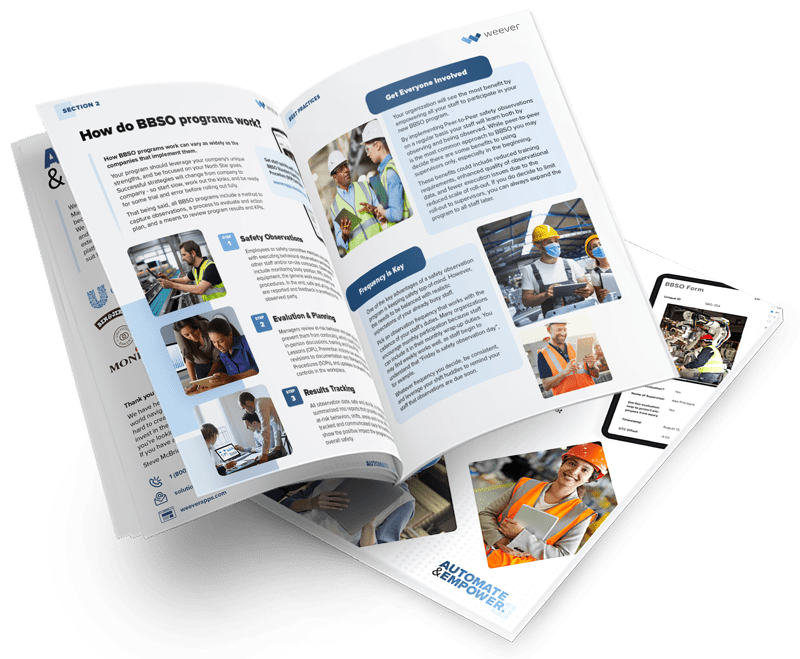6 critical success factors of Behavior-Based Safety Observation Programs
Andy Pritchard | June 23, 2022 | 5 min read

Before you being rolling out your Behavior-Based Safety Observation program, you should consider the following questions. Determining the answers to these questions will ensure a flawless rollout and save time and headaches down the road.

1) Who will be responsible for making safety observations?
Your organization will see the most benefit by empowering all your staff to participate in your new BBSO program.
By implementing peer-to-peer safety observations on a regular basis your staff will learn both by observing and being observed. While peer-to-peer is the most common approach to BBSO you may decide there are some benefits to using supervisors only, especially in the beginning.. These include reduced training requirements, enhanced quality of observational data, and fewer execution issues due to the reduced scale of roll-out.
If you do decide to limit roll-out to supervisors, you can always expand the program to all staff later.
2) How frequently will your safety observers be expected to make observations?
One of the key advantages of a safety observation program is keeping safety top of mind. However, this needs to be balanced with realistic expectations of your already busy staff. Pick a BBSO frequency that works with the cadence of your staff’s duties. Many organizations encourage monthly participation because staff can include it in their monthly wrap-up duties. You may find weekly works well, as staff begin to understand that “Friday is safety observation day”, for example. Whatever frequency you decide, be consistent, and leverage your staff huddles to remind your staff that observations are due soon.
3) How will you be recording these observations?
Understanding how you will be capturing safety observation data is an important consideration. Most companies start off with paper cards because they’re inexpensive and easy to implement.
Paper cards can be stored in a central location for easy pickup by staff, and returned to the same spot. In one example a company printed the backs of the cards green so that finished cards could be placed back in the rack and be easily spotted by the safety team. Just remember that paper forms have their own challenges that can begin to add up over the long term. Incomplete or illegible cards require follow-up. And workflow between stakeholders including safety coaching opportunities are not easily managed with paper forms.
Many organizations opt for software-based solutions which provide cost savings, real-time visibility, automated data analytics, and require less time to administration.
4) Will you be gathering the observations data to analyze it for safety trends?
Perhaps the most important consideration when planning your new BBSO program is how you will use the data you collect. Start by understanding what insights you’d like to gain from your new observation data and work backward. This approach will tell you what data you should be collecting and who needs to be involved in the analysis.
Many companies use BBSOs to inform training opportunities and One Point Lessons (OPL), update Standard Operating Procedures (SOPs), and/or simply elevate awareness of safety.
In many cases, safety managers want to understand the impact of BBSOs on the overall safety of the plant. In these cases, KPI dashboards tracking and trending at-risk behavior give you insight into the effectiveness of your ongoing training efforts.
Remember that a digital solution will help to automate reporting. This means you can set up a reporting dashboard once and the data is added automatically as it is reported, which saves time and money.
5) How will you train your staff and what does the onboarding process look like?
Program adoption can be a challenge, especially with a veteran workforce. As a result, you may find it advantageous to begin with a limited pilot program. This will allow you to get lots of helpful feedback from your early adoption team that will help you understand how BBSO will work best at your organization. You can also leverage these early adopters as champion influencers to help promote the program from within the ranks.
Cultural changes are often gradual, and not all tenured staff will be willing to participate so consider adding BBSO training to your new employee onboarding.
Invest in training videos to ensure new staff understand how the program works and its benefits. Make sure to go through each category of at-risk behaviors to help them identify unsafe work habits early.
6) How will you encourage and track participation?
Your staff are often forced to prioritize how to best spend their time at work, so it's helpful to incentivize participation in a new program like BBSO. People are usually motivated through intrinsic (internal, altruistic) or extrinsic (external, rewards) means - and usually both.
To pull on the intrinsic strings, you might want to consider spending time ensuring employees understand the positive impact that the program has on the overall safety of everyone, including them and their colleagues. Some of our customers set up a dashboard that shows program participation and some leading KPIs like Incidents and Near Misses.
Extrinsic motivators can be used as well, but be careful you are not being exploited. Some of our customers use a rewards system to stimulate participation. Others use leaderboards to stimulate competition and put the top contributors names up in “lights”.

bandjlogo

Bell-logo-New

Canadian-Tire-Logo

Diageo-customer-logo

greyston-bakery-logo

hello-fresh-customer

marks-customer-logo

CSL_Limited_logo

monin-logo

Winland Food

Mars-logo-main

rise-baking-customer-logo

Rockwool-Customer-Logo-min

Sportcheck-customer-logo

unilever-customer-logo

walmart-logo-small

husqvarna-customer-logo

Ajinomoto_logo

Peet's_Coffee_logo

Royal-Canin-Logo
